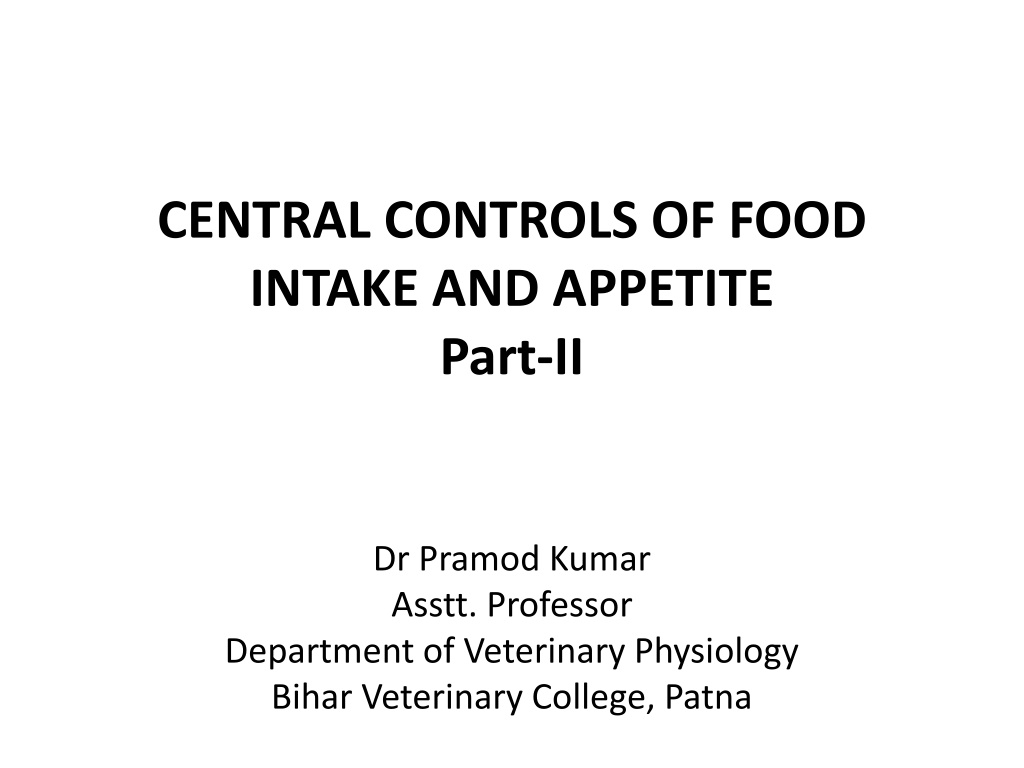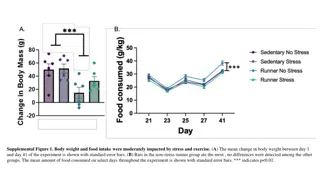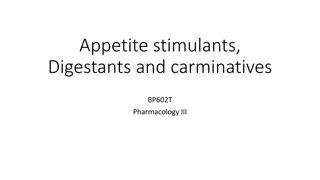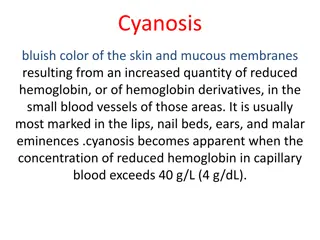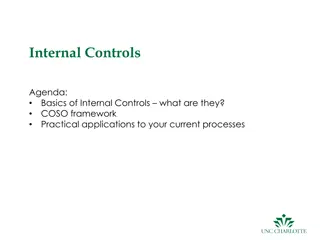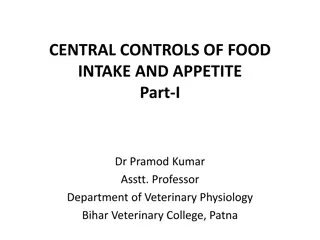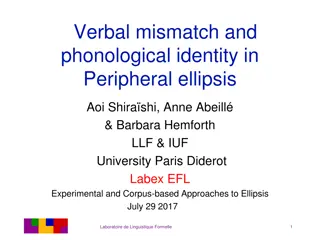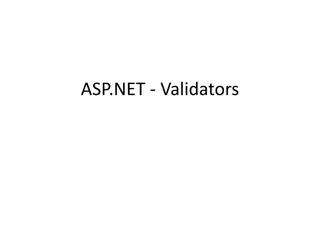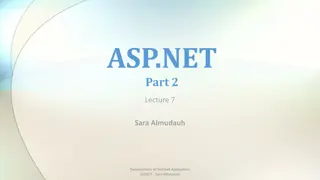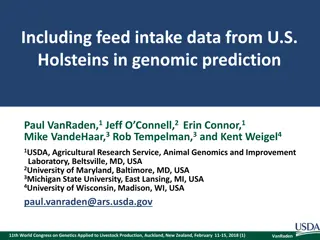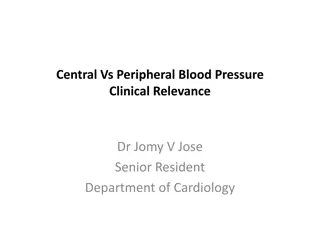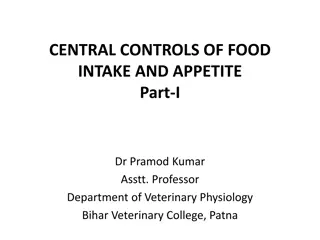Understanding Central and Peripheral Controls of Food Intake and Appetite
This article delves into the intricate mechanisms that regulate food intake and appetite, focusing on central and peripheral factors. Neural signals, gastric distention, glucose influence, circulating lipids' role, and gut hormones all play crucial roles in shaping our eating behavior. These signals from various systems work together to influence our food choices and satiety levels, highlighting the complexity of appetite regulation.
Download Presentation

Please find below an Image/Link to download the presentation.
The content on the website is provided AS IS for your information and personal use only. It may not be sold, licensed, or shared on other websites without obtaining consent from the author. Download presentation by click this link. If you encounter any issues during the download, it is possible that the publisher has removed the file from their server.
E N D
Presentation Transcript
CENTRAL CONTROLS OF FOOD INTAKE AND APPETITE Part-II Dr Pramod Kumar Asstt. Professor Department of Veterinary Physiology Bihar Veterinary College, Patna
Peripheral control of food intake and appetite Neural, nutrient and hormonal signals from the gastrointestinal system, endocrine organs, adipose tissue and circulation all have essential roles in influencing food intake and appetite.
Neural Signals appearance, taste, smell and textural stimuli Visual information - signals in the afferent optic fibers of cranial nerve I Gustatory, olfactory and orosensory information fibers of cranial nerves VII, IX, I and V brain important for taste, reward, flavor and mnemonic dorsal vagal complex, limbic system and OFC Orosensory and Optic stimuli include
Gastric Distention Volume-related postprandial gastric distention results in satiety during a meal. Mechanoreceptors in the stomach wall sense stretch volume and tension during a meal afferent fibers of the vagal & spinal visceral nerves used in the management of severe obesity
Glucose alters the firing rate of neurons in the ARC, LHA and NTS cellular influx of glucose alters the ratio of AMP to ATP within the neuronal cell ATP-dependent membrane channels that may influence neuronal depolarization alter the activity of important nutrient sensing enzymes (e.g., AMP-activated protein kinase) Some neurons (e.g., ARC POMC neurons) are excited by glucose others (e.g., ARC NPY neurons) are inhibited by glucose
Circulating lipids such as long-chain fatty acids (LCFAs) can alter feeding behavior by directly activating central neural pathways cerebro-ventricular administration of an LCFA (oleic acid) also decreased food intake by intra
Gut Hormones Ghrelin Peptide YY (PYY) Cholecystokinin (CCK) Pancreatic polypeptide (PP) Amylin Glucose-dependent insulinotropic polypeptide (GIP) Glucagon-like peptide-1, 2 (GLP-1, 2) Oxyntomodulin
Cholecystokinin CCK is synthesized in the I cells of the small intestine promote fat and protein digestion results in gallbladder contraction, relaxation of the sphincter of Oddi, somastostatin release, stimulation of pancreatic enzyme release and slowed gastric emptying afferent fibers transmit signals NTS (central melanocortin system) reduce food intake
Ghrelin is the only known gut hormone that increases appetite hunger hormone. produced by the A-cells of gastric fundus increase gastric motility and stimulation of growth hormone release increased fat storage and decrease in fat use Plasma ghrelin levels rise before meals and decline after eating
Peptide YY (PYY) is a member of PP fold family includes NPY and pancreatic polypeptide PYY is released postprandially release of PYY is augmented by dietary fat PYY administration decreases food intake in rodents and humans PYY may reduce food intake by decreasing ARC NPY levels via the ARC Y2receptor or via its effects on the vagus nerve it also delays gastric emptying.
Glucagon-like Peptide-1 Enteroendocrine L cells preproglucagon GLP-1, GLP-2 and oxyntomodulin GLP1 released postprandially - It is an incretin which results in increased glucose-dependent insulin release reduces gastric emptying and gastric acid secretion inhibits glucagon release. reduces food intake oxyntomodulin Despite similarly of GLP 1, it increases energy expenditure and may suppress ghrelin release
Pancreatic Hormones Insulin: Effect on appetite and satiety Indirect : low blood glucose increase in food intake Direct : acts on ARC insulin receptors decrease food intake Glucagon: decreases meal size, and reduces overall food intake and body weight
Pancreatic postprandially delays gastric emptying and reduce appetite exerts its effects via acting on the Y4receptors in the ARC, in the AP or via the vagus Amylin: inhibits gastric secretion, delays gastric emptying It is a satiety signal and reduces food intake and body weight polypeptide : PP is secreted
Adipose Tissue Hormones Leptin produce in adipose tissue exerts its effects by acting on the leptin receptor (LepR) acts on ARC LepR to stimulate POMC neurons and inhibit NPY/AgRP neurons to decrease food intake failure of leptin to diminish appetite in obesity is termed leptin resistance
Thyroid Hormone regulates basal metabolic state Hyperthyroidism is associated with increased food intake and decreased body weight Gonadal Steroids (orchiectomy) decreases food intake, ovariectomy increases food intake Glucocorticoids generally stimulate food intake and weight gain
